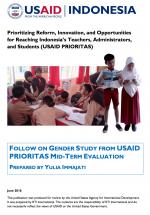Follow on Gender Study from USAID PRIORITAS Mid-term evaluation

The Mid-Term Evaluation of the USAID PRIORITAS Program, conducted in February 2015, encountered several issues related to the differences in academic performance between male and female students. These were: (1) the performance/achievement of male students is lower than that of female students; (2) female students are more active in the learning process as is evident from them being more active when carrying out tasks in a group than the male students who often just spectate; (3) there are more female teachers than male ones, but more male school principals than female ones; (4) there are no women in leadership roles at District or Provincial level or on School Committees; and (5) the training module on gender [Training on Good Practice Module II, Unit 7 on Gender in Schools] does not yet reflect the differences in culture in the various regions. This is a report on the Rapid Study that was conducted as a follow up to the mid-term evaluation. The Study has been conducted to verify the findings of the Evaluation, elaborate possible explanatory factors for the findings and suggest alternatives for addressing the issues in order to achieve better gender equality in academic achievement of boys and girls. The Study partially supports findings from the mid-term evaluation of USAID PRIORITAS. The Study confirms the first finding of the Evaluation that boys tend to have lower academic achievement than girls. At a closer look, however, there are some differences based on location (urban and rural), type of school (public and religious based schools), level of school (primary and junior secondary schools), as well as grade and class management. The mid-term evaluation, carried out by JBS International, can be found at : http://pdf.usaid.gov/pdf_docs/pa00kjxv.pdf
